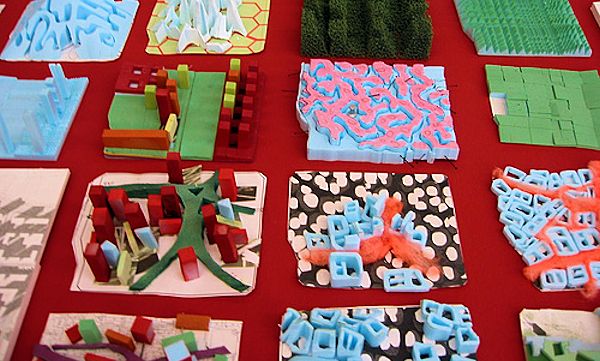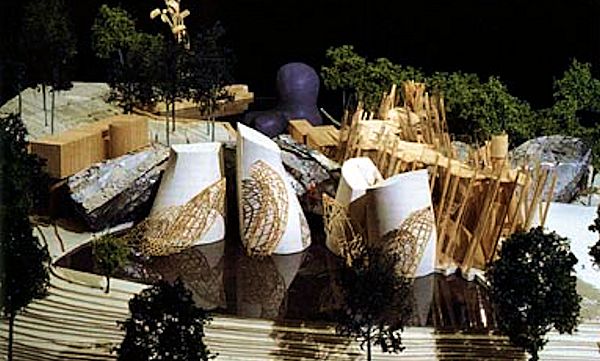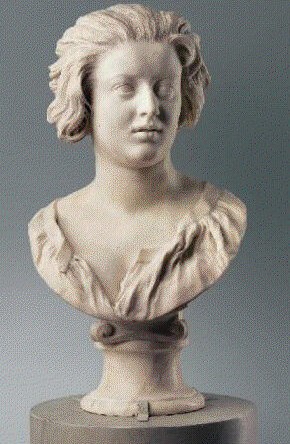2008.08.26 11:32
"wildly influential" or really only virtually influential?
[Woods'] "designs were wildly influential, closely studied by younger architects who sought to apply their ideas in the real world."
"It is my firm opinion that Eisenman is the most influential American architect of the last half of the 20th century."
and yet...
"Has the profession (and increasingly architecture is a profession not a discipline, incapable of a critical or even intelligent discourse) produced any architecture of value in the last decade? Not much."
influence : the capacity or power of persons or things to be a compelling force on or produce effects on the actions, behavior, opinions, etc., of others
So how exactly does one quantify the influence of Woods and Eisenman?
or
If Woods and Eisenman are indeed so influential, then perhaps they should be held accountable.
2008.08.24 08:43
peter's canon
I am quite surprised by the many who have not recognized Gehry's influence. If anything, he joined and most clearly built a unity of modernist architecture as self referential practice of structure and the same as a flexible practice of hyper-noumena; that is to say a compound of the mineral tectonics of here-and-now and the sating buffet of architectonic plasma.
Modern architecture is fully present and wide awake, and all the quondam dreams and nightmares now manifest reality itself. Is not then a prescriptive therapeutic and/or pharmaceutical architecture surely to be marketed as well?
2008.08.23 22:55
peter's canon
To suspect that Eisenman's process conceals a much more pliant process doesn't eliminate Gehry's already self-evident very pliant process. Gehry's entire oeuvre is evidence of a very pliant design process.
Has Eisenman really been designing a process? It looks to me more like he's been designing a determinism, and I am personally aware of an aspect of Eisenman's process that proves very inflexible.
2008.08.23 21:06
peter's canon
Personally, I like seeing all the study models of various projects by various architects. I like it because it clearly demonstrates just how pliant architectural designing can be. And I seriously consider the notion that it may well be Gehry that best introduced architectonic pliancy to the profession.
Is architectonic pliancy in somewhat sharp contrast to Eisenman's method? Up to a certain point (in time) I'd say yes. And when Eisenman's work started exhibiting some measure of pliancy, that's where I start to see Gehry's influence.
Have Gehry's designs of late become somewhat predictable and/or seemingly uninspired? Perhaps the pliability metaphor applies here too; perhaps the pliancy has been lost for being stretched too much and too far.
Another thing I like about all the study models is that so often almost any one of the models looks to be an exciting and/or interesting building. And often too it is within the collection of study models that one finds the riskier designs. "Getting it right" isn't the only operation going on. There's also a having-to-let-go of good designs.
| |
2008.08.23 17:01
peter's canon
...you made some leaps in explaining design logic, characterized Koolhaas's and Gehry's method without at least some backup example, and then mixed historiographic metaphors.
If "multiple study models, repeated ad infinitum, is a reflection of contemporary notions of representation," then where do you think this process came from?
"How an object can take any form, yet retain a defined purpose. Through modern technology, one truly can devise any form imaginable and then frankenstein the program, or purpose, into it. In some cases there is a deliberateness to this process, like in some of OMA's projects. While in many of Ghery's projects, the process is not deliberate and the form is completely separated from function."
The negative conclusion here seems to be no different than the positive opening premise. And how do you gauge this deliberateness or lack of deliberateness?
The whole duck/decorated shed thing is now like an unfortunate abused child. Poor thing, it's still not left alone.
2008.08.23 15:16
peter's canon
One thing that crossed my mind last night was how, when I see the many study models of H&dM...

...and OMA...

..I'm reminded of the many study models produced by Gehry for the Lewis Residence...

(I may be stretching it, but...)
Gehry's method of design via innumerable study models seems to have become quite influential.
Personally, I like seeing all the study models of various projects by various architects. I like it because it clearly demonstrates just how pliant architectural designing can be. And I seriously consider the notion that it may well be Gehry that best introduced architectonic pliancy to the profession.
Is architectonic pliancy in somewhat sharp contrast to Eisenman's method? Up to a certain point (in time) I'd say yes. And when Eisenman's work started exhibiting some measure of pliancy, that's where I start to see Gehry's influence.
Have Gehry's designs of late become somewhat predictable and/or seemingly uninspired? Perhaps the pliability metaphor applies here too; perhaps the pliancy has been lost for being stretched too much and too far.
Another thing I like about all the study models is that so often almost any one of the models looks to be an exciting and/or interesting building. And often too it is within the collection of study models that one finds the riskier designs. "Getting it right" isn't the only operation going on. There's also a having-to-let-go of good designs.
To suspect that Eisenman's process conceals a much more pliant process doesn't eliminate Gehry's already self-evident very pliant process. Gehry's entire oeuvre is evidence of a very pliant design process.
Has Eisenman really been designing a process? It looks to me more like he's been designing a determinism, and I am personally aware of an aspect of Eisenman's process that proves very inflexible.
| |
2008.08.23 00:03
If it ain't Baroque, don't fix it.
Perhaps the sordid love quadrilateral between Costanza (the art collector and dealer), her husband Bernini's assistant, Bernini, and Bernini's brother was something of an inspiration for the Due Teatri

Portrait of Costanza Bonarelli, c. 1636-37.
Due Teatri, 1637.
2008.08.22 23:16
peter's canon
...I have no inclination to 'correct' your personal probings into matters of faith.
The Incredulity of Saint Thomas is interesting however. Caravaggio depicts an event that the Bible doesn't actually say happened. You could say that Caravaggio is playing with history a bit. But was Thomas really doubting Christ, or did he just feel left out? Maybe John too played a bit with 'history' by using Thomas' supposed expressed doubt as an object lesson in blind faith. In all fairness, John is the only Apostle on record (written by John himself) to have believed in the ressurected Christ before seeing the ressurected Christ. (Read John, chapter 20 carefully.) The ressurected Christ first appeared to Mary Magdalene and she didn't know it was Him. All the other Apostles (except Thomas) got to see the ressurected Christ Easter night, and He made an explicit show of His hands and side. So it really isn't all that wrong for Thomas to say, "I want Him to show me his hands and side too." He deserved that treat as much as the rest of them.
| |
2008.08.22 22:05
peter's canon
Just did a side by side chronological overview of the work of Gehry and Eisenman, and in terms of architectonic, geometrical experimentation, Gehry manifests a greater and more mature repertoire.
Eisenman goes through a lot of intellectual and theoretical rigor to ultimately arrive at his geometry, but Gehry simply demonstrates that the intellectual and theoretical rigor isn't even necessary when it come to unprecedented architectonic geometries.
The only reason Eisenman's approach gets respect is because it fits well into 'higher' education. To have students pay large amounts of money to then learn that, "Hey, just look at Gehry, you can design pretty much anyway you want these days." just wouldn't go over well.
2008.08.22 21:00
peter's canon
If that's that case, then don't leave out the influence of Gehry on late Eisenman.
2008.08.22 20:07
peter's canon

Michelangelo originally painted God nude too. And note how the left arm of God is around His final creative act, Eve.
After first creating light, God's second act of creation in the Book of Genesis manifests an obvious duality-- the separation of light from darkness. Dual manifestations in Genesis do not end with day and night, however. The biblical creation account is essentially a list of one duality after another. The distinction of an upper and lower firmament creates heaven and earth, and the separation of land and seas further distinguishes the earth.
God distributes nature throughout the earth, and from the dust of the earth God's creativity culminates with the creation of the human species. God gives humanity dominion over nature, and places the first human in the Garden of Eden, where the sequence of dualities continues. Within the Garden, there are two distinct trees. The first tree, the tree of life, bears the fruit of eternal life. The second tree, the tree of knowledge of good and evil, bears the only fruit God forbids the first human to eat. Besides the dualism explicit in the second tree's name, the tree also represents death, since to eat of the fruit is to die. God then separates humanity into male and female, thus performing his final creative act. In all, the primordial phase of Genesiss establishes seven dualities--light and darkness; heaven and earth; land and sea; nature and humanity; life and death; good and evil; male and female.
Humanity's first act, in the Book of Genesis, also manifests a duality. The first couple's earliest act was to eat the forbidden fruit, and this misdeed, which caused God to expel them from the Garden, initiated the penultimate duality of Genesis--the separation of God and humanity. Thereafter, duality appears one final time in the first couple's offspring, two brothers, one good and the other evil. The evil brother kills the good brother, and thus, by murder, a human manifests the first death.
That duality is the very basis of existence and reality is implicit throughout the beginning of Genesis. The primal acts, of both God and humanity, result in firm dualities that constitute everything from the cosmos to the human condition. Most of the dualities come to be through an act of separation, and, at times, one component of an already existing duality separates and manifests a new duality. It is difficult, at this point, to state with certainty whether this progression of dualities contains a message or speaks of a significant system, however, there is certainty that Genesis is not the only creation story rooted in dualities. Creation accounts featuring dual manifestations is a global phenomenon. Almost all accounts begin with the dualities of heaven and earth; male and female; good and evil, and some accounts give special emphasis to the duality of creation and destruction.
Lauf, 1995
|